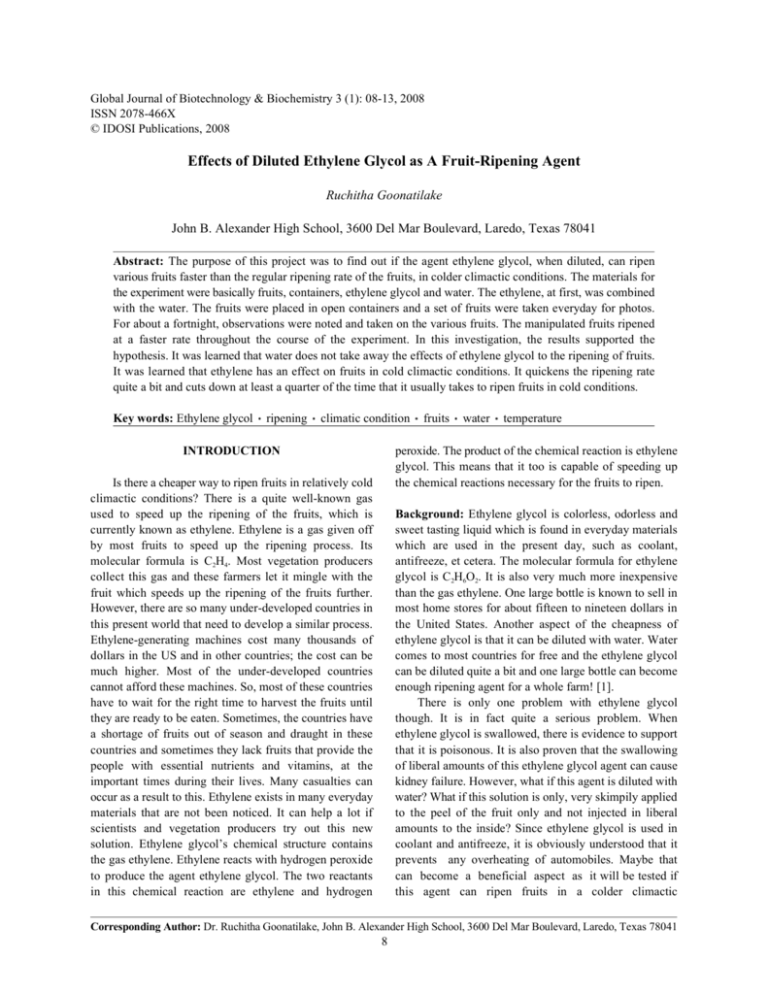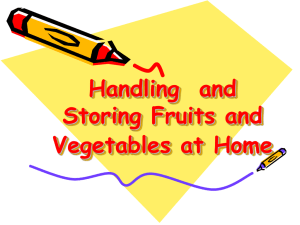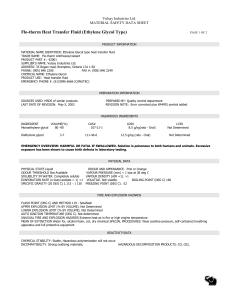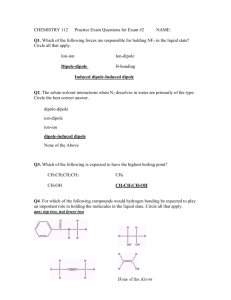Effects of Diluted Ethylene Glycol as A Fruit-Ripening Agent
advertisement

Global Journal of Biotechnology & Biochemistry 3 (1): 08-13, 2008 ISSN 2078-466X © IDOSI Publications, 2008 Effects of Diluted Ethylene Glycol as A Fruit-Ripening Agent Ruchitha Goonatilake John B. Alexander High School, 3600 Del Mar Boulevard, Laredo, Texas 78041 Abstract: The purpose of this project was to find out if the agent ethylene glycol, when diluted, can ripen various fruits faster than the regular ripening rate of the fruits, in colder climactic conditions. The materials for the experiment were basically fruits, containers, ethylene glycol and water. The ethylene, at first, was combined with the water. The fruits were placed in open containers and a set of fruits were taken everyday for photos. For about a fortnight, observations were noted and taken on the various fruits. The manipulated fruits ripened at a faster rate throughout the course of the experiment. In this investigation, the results supported the hypothesis. It was learned that water does not take away the effects of ethylene glycol to the ripening of fruits. It was learned that ethylene has an effect on fruits in cold climactic conditions. It quickens the ripening rate quite a bit and cuts down at least a quarter of the time that it usually takes to ripen fruits in cold conditions. Key words: Ethylene glycol ripening climatic condition INTRODUCTION fruits water temperature peroxide. The product of the chemical reaction is ethylene glycol. This means that it too is capable of speeding up the chemical reactions necessary for the fruits to ripen. Is there a cheaper way to ripen fruits in relatively cold climactic conditions? There is a quite well-known gas used to speed up the ripening of the fruits, which is currently known as ethylene. Ethylene is a gas given off by most fruits to speed up the ripening process. Its molecular formula is C2H4. Most vegetation producers collect this gas and these farmers let it mingle with the fruit which speeds up the ripening of the fruits further. However, there are so many under-developed countries in this present world that need to develop a similar process. Ethylene-generating machines cost many thousands of dollars in the US and in other countries; the cost can be much higher. Most of the under-developed countries cannot afford these machines. So, most of these countries have to wait for the right time to harvest the fruits until they are ready to be eaten. Sometimes, the countries have a shortage of fruits out of season and draught in these countries and sometimes they lack fruits that provide the people with essential nutrients and vitamins, at the important times during their lives. Many casualties can occur as a result to this. Ethylene exists in many everyday materials that are not been noticed. It can help a lot if scientists and vegetation producers try out this new solution. Ethylene glycol’s chemical structure contains the gas ethylene. Ethylene reacts with hydrogen peroxide to produce the agent ethylene glycol. The two reactants in this chemical reaction are ethylene and hydrogen Background: Ethylene glycol is colorless, odorless and sweet tasting liquid which is found in everyday materials which are used in the present day, such as coolant, antifreeze, et cetera. The molecular formula for ethylene glycol is C2H6O2. It is also very much more inexpensive than the gas ethylene. One large bottle is known to sell in most home stores for about fifteen to nineteen dollars in the United States. Another aspect of the cheapness of ethylene glycol is that it can be diluted with water. Water comes to most countries for free and the ethylene glycol can be diluted quite a bit and one large bottle can become enough ripening agent for a whole farm! [1]. There is only one problem with ethylene glycol though. It is in fact quite a serious problem. When ethylene glycol is swallowed, there is evidence to support that it is poisonous. It is also proven that the swallowing of liberal amounts of this ethylene glycol agent can cause kidney failure. However, what if this agent is diluted with water? What if this solution is only, very skimpily applied to the peel of the fruit only and not injected in liberal amounts to the inside? Since ethylene glycol is used in coolant and antifreeze, it is obviously understood that it prevents any overheating of automobiles. Maybe that can become a beneficial aspect as it will be tested if this agent can ripen fruits in a colder climactic Corresponding Author: Dr. Ruchitha Goonatilake, John B. Alexander High School, 3600 Del Mar Boulevard, Laredo, Texas 78041 8 Global J. Biotech. & Biochem., 3 (1): 08-13, 2008 environment, since it might take some fruits longer to ripen in the colder environments especially in those countries that have colder climactic conditions throughout most of the year [2]. There is much this experiment can inform if the expected results come out of it. It can really be quite a benefit for the future of harvesting and the future of mankind. There are also many predictions that can be made based on the information gathered on the original review of literature which is basically the research findings discovered through various means and quite a diverse group of sources. Based on these research findings and of the literature obtained, a hypothesis, or testable question can be obtained. The hypothesis of the experiment will be stated shortly. When the ethylene glycol is applied to the manipulated variables of the experiment, it will cause the premature ripening of the fruits, since they have been exposed to an “overdose” of ethylene. The ethylene glycol will essentially speed up the ripening process and in the colder environment; its effects will still work as its modern, ordinary purpose is to prevent the overheating of automobiles. The variables of which had not been manipulated will not ripen at the rate of those fruits which had been exposed to the ethylene glycol solution [3]. Many experiments have been conducted over this subject. One known experiment was conducted by Greer and Girding, 1988. The scientists conducted an experiment on ethylene as well. Greer and Girding’s experiment was how extra exposure to ethylene would affect fruit-ripening. The data and observations from the experiment showed that an overexposure to ethylene does indeed take effect and speeds up the ripening process of most fruits even faster than before. Greer and Girding also investigated if the acidity of the fruit was affected as to how the ripening occurred. These scientists wanted to know if more acidic fruits ripened more rapidly than the fruits of lesser acidity. The experiments they conducted displayed the information that showed that the more acidic the fruit, the faster it ripened. This means that if a scientist was measuring the ripening rate of a banana and an apple, the banana would ripen first since its acidity is more than that of the apple. This investigation showed to be valid and they proved a very important theory that was not very well-known at the time. It also helped out in the real world and many farmers and harvesters made use of it. An experiment conducted by Henry Remisson’s experiment was to seek the cause of fruit ripening in [4]. Henry worked in France as a biologist and he retested what was said about ethylene as the cause for the ripening of fruits. The experiments supported the theory that ethylene was the gas that many plants excreted which caused the ripening of the fruit itself. In the experiment many fruits were overexposed to the gas and the results were very important findings. They supported the theory that the amount of ethylene also determined at what time precisely or the rate of the ripening of the various fruits that the experiment Henry Remisson tested [5]. Another known experiment was conducted in England, at Oxford University by William Cummings and a few of other colleagues in the science department of the prestigious university. William conducted various experiments on ethylene and retested many experiments conducted by various other scientists including the previously mentioned Henry Remisson. William found the results were not dissimilar to those of Henry Remisson’s. The overexposure to the ethylene did exactly what it had done previously in that the fruits ripened much more rapidly than those rates of the regular variables in Cummings’s experiment. However, Will was not content from just those discoveries. This scientist went on to test several other hypotheses. Cummings also conducted an experiment to test whether climate had a roll in the results of a test of ethylene exposure to various types of fruits. Cummings, in testing this hypothesis, discovered that climate did indeed have a roll in the ripening rate of fruits even with the overexposure to ethylene. The colder the climate was in the environment of the experiment, the slower the rate was when the ripening rate was investigated in the experiment. The temperature truly affected the ripening rate of the fruits [6]. Another known experiment was done by Wesley Knoll and Don Stewart of St. Mary’s Institute of London. Knoll and Stewart’s experiment was something like that of the previously mentioned experiment except that they proved their discovery a few years before the previously mentioned experiment. The scientists conducted their experiment in 1971 and they discovered that ethylene not only caused the ripening of the fruits of the world but also could speed up the process of ripening, which made the fruits edible. The exposure to ethylene was what caused different chemical reactions to occur and caused the fruits to ripen [7]. These experiments are very valid and they have completely proven the points they under took their projects to prove. However, the experiments lacked something very similar. They both did not look for a speedier way to ripen the fruits a faster way in colder conditions. It would have been much more useful and beneficial to the real world if they had stated, researched 9 Global J. Biotech. & Biochem., 3 (1): 08-13, 2008 and investigated those topics and included that information in their experiments. texture. The mangos still seem firm through the course of one day. The mangos still have not showed signs of ripening, just like the apples and the nectarines. The lemons which were coated with the diluted solution of ethylene glycol and water seemed to show signs of ripening. Those lemons seemed to have a richer, deeper yellow coloration of them. The other lemons are pale yellow. However, the texture of both the variables seemed to have no difference between them. In day 2, the bananas which were manipulated are losing some more of the green coloration. The other bananas are still, color-wise, the same since the experiment was started. The nectarines which were manipulated seem to be softer texture-wise. There does not seem to be much of a difference between the two color-wise. The apples still have not changed at all, both variables, color-wise or texture-wise. The mangos appear just the same, except the fact that the manipulated mango was lesser firm to the touch than the texture of the regular mango. The lemons, both variables, texture-wise, seem to be rather less firm to the touch. Despite this fact, the colors of the two lemons appear to be exactly the same as the previous day. In day 3, no noticeable changes occurred. This may have occurred since there was rain outside and the external temperature dropped rather dramatically. This external temperature may have affected the temperature inside where the fruits were placed in and therefore must have altered the ripening process. The bananas seemed the same, as did all of the other fruits. In day 4, observation reveled that all of the banana variables have lost a little bit of the green coloration. Of course, the manipulated variables are ripening a little bit quicker. Today was much warmer and no rain occurred, so the results were expected. Nectarines, both variables, have lost their hard texture. The regular fruits are firmer to the touch than the nectarines with the diluted solution applied to the peel. The colors appear to be the same. The apples have hard textures still, but the texture is not as hard as is it once was especially the apples with the ethylene glycol applied to their skins. The colors appear to be the same as ever for both of the apples. No noticeable change has come upon both variables on the mangos. The regular lemons’ skins are turning a little less pale. However they have not yet reached the rich, yellow color of the manipulated lemons. The manipulated lemons are becoming softer and less firm to the touch. The formerly pale lemons are still quite firm texture-wise. In day 5, the manipulated bananas have all lost their green coloration. This shows that they have ripened. Procedure: The ethylene glycol is mixed into the water using one part ethylene glycol to four parts water (20% ethylene glycol and 80% water). A brush has been used to apply the diluted agent after dipping shallowly into the ethylene glycol solution. They have been applied sparingly to the manipulated variables, twenty bananas, twenty lemons, twenty mangos, twenty apples and twenty nectarines, all unripe. Immediately after applying the solution onto the peels of the fruits, placed them, individually, into open separate containers. Place the containers into a large, dry place where the temperature is approximately eight degrees Celsius. Now place the rest of the fruits into the rest of the open containers. Be careful now NOT to apply the ethylene glycol solution to these fruits since they are not the manipulated variables. Place these containers in the cool, dry place as well. Make sure they are placed in the containers. Leave fruits in the containers and the cool, dry place for an interval of about two and a half weeks. Take observations of the progress of the ripening of the fruits, but leave the containers open until the interval of two and a half weeks has finished. After the two and a half week interval, dispose of the fruits and the solution properly, in bio-hazardous waste containers or whatever is necessary at the time. All observations and data and all calculations, afterwards were recorded. The essential materials needed to conduct this experiment were: Forty unripe Apples, Forty unripe Bananas, Forty unripe Lemons, Forty unripe Mangos, Forty unripe Nectarines, Two-hundred containers with lids, One quart of Ethylene Glycol agent, Three gallons of Distilled Water, Thermometer (Celsius), Cold storage room with an average temperature of about eight degrees Celsius, Toothbrush or small paintbrush for means to apply agent to fruits Observations: In day 1, there were not noticeable changes on the first day. Subsequently, the bananas with the solution applied to them appeared to have lost a shade of green. The other bananas still remain as green. The nectarines, specifically, both variables seemed to have absolutely no difference. All of the nectarines have the same color as original and all of the nectarines still have the same firm and hard texture, which means they have not ripened at all yet. The apples, like the nectarines, seem to have not changed at all through the course of one day. The apples still had the dark red coloration and the hard 10 Global J. Biotech. & Biochem., 3 (1): 08-13, 2008 These are the first fruits to become completely ripe. Their texture is also extremely soft. Black splotches have spread along throughout the bananas. Something rather odd has occurred with the regular bananas. In some places, these bananas are turning white. So, regular bananas are affected by cold weather. The apples are not showing any new changes as are the mangos and the lemons. However, the nectarines which were manipulated are less-firm. The skin along with the flesh is extremely easy to squeeze, quite “squashy”. The coloration is also becoming yellow, to a peach-like color. In day 6, the lemons which were manipulated have ripened. They are yellow as can be and texture-wise, they are very soft. The other lemons are still very pale and firm. The two colors of the different apples are very different as well. The apples which were manipulated are darker color-wise, but are very soft. The apples which were not manipulated are lighter color-wise, but are firm to the touch. The nectarines are the same as the previous day. The mangos which were manipulated are slightly gaining an edge towards ripening than the regular mangos because they are much less firm than the regular mangos. In day 7, the nectarines (of the manipulation) which were showing significant signs of ripening in the past few days have finally ripened. They are extremely soft and yellow, with only a tinge of red. Of the other fruits, no noticeable changes have come upon them. The mangos which were manipulated also fully ripened on this day. The apples which were manipulated are showing much promise. The apples are really looking like they will ripen in the very near future. The bananas which were not manipulated are losing their green coloration as well. In day 8, the apples which were manipulated have ripened today. It took time but it still beat out the regular apples which are not close to ripening. The bananas which were not manipulated have ripened at last. They really ripened late compared to the manipulated bananas. The rest of the variables are not showing much promise except for the lemons, amazingly. In day 9, the lemons have also ripened today. The nectarines are less-firm to the touch and the mangos are similar to those of nectarines. The apples look like they are going to take much more time to ripen. In day 10, the nectarines which were not manipulated have ripened. They were not at all firm and color-wise, they met the expectations for ripening. The mangos are looking extremely promising as well. In day 11, the mangos which were looking really promising yesterday have also ripened. The order in which the fruits are ripening without being manipulated is somewhat different from the manipulated fruits. In day 12, the apples have not yet ripened. They are undergoing small changes day by day. Nothing else is to be said since all the other fruits ripened already. In day 13 (final day), the apples have ripened at last. The apples took the longest time to ripen. This is where most people notice the benefits of this manipulation. The manipulation has saved time for those lived in underdeveloped countries to flourish their business and daily consumption of fruits. RESULTS Table 1 shows the summary of reaction on various fruits observed as a result of this ripening agent. A column graph has been drawn to compare fruits and that of manipulated fruits during the period of observation. Table 2 is used to calculate the percentages of time saved in ripening the fruits from ethylene glycol during the observation period. Table 1: Summary of noticeable reaction among different fruits Apples Lemons Day 1 Bananas 0 Mangos 0 Nectarines 0 0 0 Day 2 1 0 1 0 1 Day 3 1 0 1 0 1 Day 4 2 0 2 0 1 Day 5 5 0 4 0 2 Day 6 9 1 7 2 6 Day 7 13 8 11 5 10 Day 8 17 12 15 9 14 Legends: 0 – No noticeable change, +1 – Weak noticeable change, +2 – Somewhat noticeable, +3 – Noticeable change, +4 – Strong noticeable change Table 2: Computation of percentages of time saved on selected fruits Days taken Hrs. Order of Fruits 11 to ripen Percentage of Hrs. saved Ripening time saved Manipulated bananas 5 days 120 72 1 37.50% Manipulated mangos 7 days 168 96 3 36.36% Manipulated nectarines 7 days 168 72 3 30.00% Manipulated apples 8 days 192 120 5 38.46% Manipulated lemons 6 days 144 72 2 33.33% Average 6.6 days 86.4 Regular bananas 8 days 192 -72 1 Regular mangos 11 days 264 -96 3 Regular nectarines 10 days 240 -72 4 Regular apples 13 days 312 -120 5 Regular lemons 9 days 216 -72 2 Average 10.2 days -86.4 Global J. Biotech. & Biochem., 3 (1): 08-13, 2008 14 12 Manipulared Fruits Fruits Comparison fo Fruits manipulated lemons ripened on the sixth day. The regular lemons ripened on the ninth day. The manipulated apples ripened on the eighth day. The regular apples ripened on the thirteenth day. In all, the average amount of days saved was three point six (3.6). So all in all, ethylene glycol, diluted with water, has effects on the ripening of various fruits in cold climactic conditions. It was discovered that Ethylene glycol is easily soluble in water. It was learned that water does not take away the effects of ethylene glycol to the ripening of fruits. It was learned that ethylene has an effect on fruits in cold climactic conditions. Usually, colder weather slows down the ripening of fruits. It quickens the ripening rate quite a bit and cuts down at least a quarter of the time that it usually takes to ripen fruits in colder conditions. This would really benefit underdeveloped countries because ethylene glycol is so much cheaper than ethylene gas generators. However, there are sources of error in this experiment. Probably the largest source of error was the identification of the ripening. The ripening rate of the fruits was measured on the texture of the fruit. If it was soft, it was considered ripe. The color varied with the different fruits. However, the results for another conductor of the experiment might have different results. That was one source of error. The next source of error was the fact that the fruits might not have been harvested or planted at precisely the same time. Any difference in the harvesting or planting times may have also altered the results from what they should have been. Another source of error is the fact that the ethylene glycol may not have been evenly distributed between the various fruits. Some fruits received more of the solution while the others did not. This may also have altered the results of the experiment. Many things could have been done to this experiment to make it better. First of which would be to make this experiment in a mass scale. This would support the hypothesis more and make it closer to being proved. Another thing that could have been done is to lower the temperatures in which the fruits are experimented in. That would really show the effects of the ethylene glycol on the fruits. Yet another way would be to use even less amount of ethylene glycol in the solution and compare it to the results of this experiment. Another way to make this experiment better would be to test the ethylene glycol solution on the fruits and then test the fruits on animals to see if the solution does not cause any damage to any part or portion of the animal’s interior because of the ethylene glycol. 10 8 6 4 2 0 1 2 3 Fruits 4 5 Fig. 1: Comparison of fruits (1-Bananas, 2-Mangos, 3Nectorines, 4-Apples, 5-Lemons) Lemons have an average acidity of about 2.2. Bananas have an average acidity of 3.4. Nectarines have an average acidity of about 3.9. Mangos have an average acidity of about 4.3. Apples have an average acidity of about 5.7. All these fruits are acidic. The order in which these fruits ripened in this experiment was first, bananas, second, lemons, third mangos and nectarines and fifth, apples, respectively. Those were the manipulated fruits. The regular fruits’ order was first, bananas, second, lemons, third mangos, fourth, nectarines and fifth apples. It was deserved that the more acidic fruits ripened quicker than the lesser acidic fruits. This pattern was found to be consistent with both variables of the different fruits selected. However, the order was different with the manipulated and regular fruits since the mangos ripened faster than the nectarines in the regular category whereas the manipulated mangos and nectarines ripened on the same day. CONCLUSIONS It was found out if the agent ethylene glycol, when diluted with water, will ripen various fruits faster in colder climactic conditions. In this individual field investigation, the results supported the hypothesis. The hypothesis basically stated that if the ethylene glycol is applied (after being diluted with water) to the various fruits, then it will speed up the ripening process on the fruits in colder climactic conditions, cutting down at least a quarter of the time it usually takes for the fruits to ripen. The manipulated fruits were ripened at a much faster rate than the regular fruits. The manipulated bananas ripened on the fifth day. The regular bananas ripened on the eighth day. The mangos which were manipulated ripened on the seventh day. The regular mangos ripened on day eleven. That is a savings of four days. The manipulated nectarines ripened on the seventh day. The regular nectarines ripened on the tenth day. The 12 Global J. Biotech. & Biochem., 3 (1): 08-13, 2008 ACKNOWLEDGEMENTS 2. The work of this paper has been presented at the 19th Annual United Independent School District (UISD) Science Fair, an affiliate of the International Sciences and Engineering Fair, Laredo, Texas held on Friday, March 31, 2007 and received a fifth place award in the category of Biochemistry and Chemistry. It would be good to thank many people for this project investigation. Of them, many appreciations are due to parents of the author for their everlasting support and buying all of the essential materials. Secondly, the faculty at TAMIU deserved many thanks for setting up a place where the experiment could take place. Finally, all the scientists who conducted similar experiments from them this experiment have been emulated. Mrs. Lopez at John B. Alexander High School should be thanked for helping around with the format of the experiment. REFERENCES 1. Wikipedia Encyclopedia, 2003. Ethylene, Ethylene Glycol, Retrieved September, 14, 2006 from www.wikipedia.com/ethylene 13 3. 4. 5. 6. 7. McCullough, Adrian. 1979. Fruit-Ripening and Chemical Reactions. Chemical Reactions in Nature, Vanderbilt University Press. Harrison, R., 1989. Is there a Faster Fruit-Ripening Process? The British Magazine of Science, pp: 51-53. Missing Remisson, H., 1983. Fruit-Ripening and its Causes. Canadian Journal of Science, pp: 73-77. Cummings, William. July, 1986. Overexposure to Ethylene Helps Ripening! American Scientific, pp: 93-97. Knoll, Wesley and Stewart, Don 1971. Effects of Plant Ripening when Overexposed to Ethylene. Retrieved September 15, 2006 from www.stmary sinstitute.org. uk/chemistry/ethylene.







